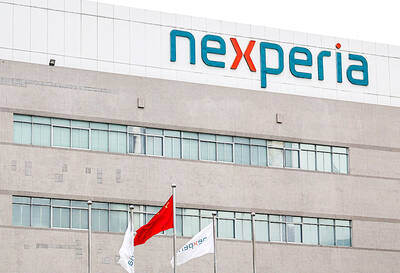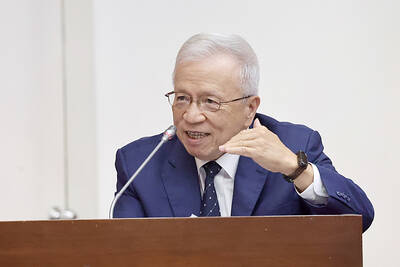Passive components manufacturer Yageo Corp (國巨) expects to see its revenue grow by 3.62 percent this year, benefiting from the company’s latest price hike on chip resistor products, First Capital Management Inc (第一金投顧) said on Thursday.
The company’s price increases of 15 to 20 percent on certain chip resistor products, announced on Wednesday, could increase revenue by NT$1.17 billion (US$39.53 million), while boosting its gross margin by between 3 and 4 percentage points and lifting its earnings per share by NT$0.9, First Capital said in a statement.
Yageo is one of the world’s major suppliers of resistors — an electronic component used to resist or reduce the amount of current flowing in an electronic circuit — controlling one-third of the global market share, with rivals including Taiwan’s Walsin Technology Corp (華新科) and Ralec Electronic Corp (旺詮), as well as Japan’s Rohm Co Ltd and KOA Corp, Taishin Securities Investment Advisory Co (台新投顧) said in a separate statement on Thursday.
Yageo reported total revenue of NT$32.26 billion last year, up 8.91 percent from 2016, as the company raised prices for its multilayer ceramic capacitor (MLCC) products four times throughout the year amid a supply crunch.
Chip resistor sales contributed NT$14.2 billion to Yageo last year, accounting for about 44 percent of its total revenue, with MLCCs making up 50 percent, Taishin said.
Viking Tech Corp (光頡科技), a supplier of resistors and inductors, also on Thursday announced that it would raise prices for several chip resistors by 10 percent, due to higher prices for raw materials such as packaging material, paste, electroplating material and ceramic substrate.
Yageo’s and Viking Tech’s price hikes came after Ralec announced on Jan. 2 that it would raise prices for some chip resistor products by up to 15 percent for greater China distributors and agents.
The shortage in chip resistor supplies began in the third quarter of last year and the situation is expected to persist into the first half of this year, as major manufacturers in Japan are moving to focus on high-end products amid a trend toward automotive electronics, analysts said, adding that increases in resistor supplies at Taiwanese suppliers have been limited, while raw material and labor costs continue to rise and the New Taiwan dollar struggles against the US dollar, analysts said.
Yageo’s stock price closed 2.98 percent lower at NT$375 in Taipei trading on Friday.
Over the past 12 months, the stock has surged more than 466 percent, compared with the main bourse’s 15.7 percent rise over the same period, Taiwan Stock Exchange data showed.

JITTERS: Nexperia has a 20 percent market share for chips powering simpler features such as window controls, and changing supply chains could take years European carmakers are looking into ways to scratch components made with parts from China, spooked by deepening geopolitical spats playing out through chipmaker Nexperia BV and Beijing’s export controls on rare earths. To protect operations from trade ructions, several automakers are pushing major suppliers to find permanent alternatives to Chinese semiconductors, people familiar with the matter said. The industry is considering broader changes to its supply chain to adapt to shifting geopolitics, Europe’s main suppliers lobby CLEPA head Matthias Zink said. “We had some indications already — questions like: ‘How can you supply me without this dependency on China?’” Zink, who also

At least US$50 million for the freedom of an Emirati sheikh: That is the king’s ransom paid two weeks ago to militants linked to al-Qaeda who are pushing to topple the Malian government and impose Islamic law. Alongside a crippling fuel blockade, the Group for the Support of Islam and Muslims (JNIM) has made kidnapping wealthy foreigners for a ransom a pillar of its strategy of “economic jihad.” Its goal: Oust the junta, which has struggled to contain Mali’s decade-long insurgency since taking power following back-to-back coups in 2020 and 2021, by scaring away investors and paralyzing the west African country’s economy.

Taiwan Semiconductor Manufacturing Co (TSMC, 台積電) received about NT$147 billion (US$4.71 billion) in subsidies from the US, Japanese, German and Chinese governments over the past two years for its global expansion. Financial data compiled by the world’s largest contract chipmaker showed the company secured NT$4.77 billion in subsidies from the governments in the third quarter, bringing the total for the first three quarters of the year to about NT$71.9 billion. Along with the NT$75.16 billion in financial aid TSMC received last year, the chipmaker obtained NT$147 billion in subsidies in almost two years, the data showed. The subsidies received by its subsidiaries —

BUST FEARS: While a KMT legislator asked if an AI bubble could affect Taiwan, the DGBAS minister said the sector appears on track to continue growing The local property market has cooled down moderately following a series of credit control measures designed to contain speculation, the central bank said yesterday, while remaining tight-lipped about potential rule relaxations. Lawmakers in a meeting of the legislature’s Finance Committee voiced concerns to central bank officials that the credit control measures have adversely affected the government’s tax income and small and medium-sized property developers, with limited positive effects. Housing prices have been climbing since 2016, even when the central bank imposed its first set of control measures in 2020, Chinese Nationalist Party (KMT) Legislator Lo Ting-wei (羅廷瑋) said. “Since the second half of